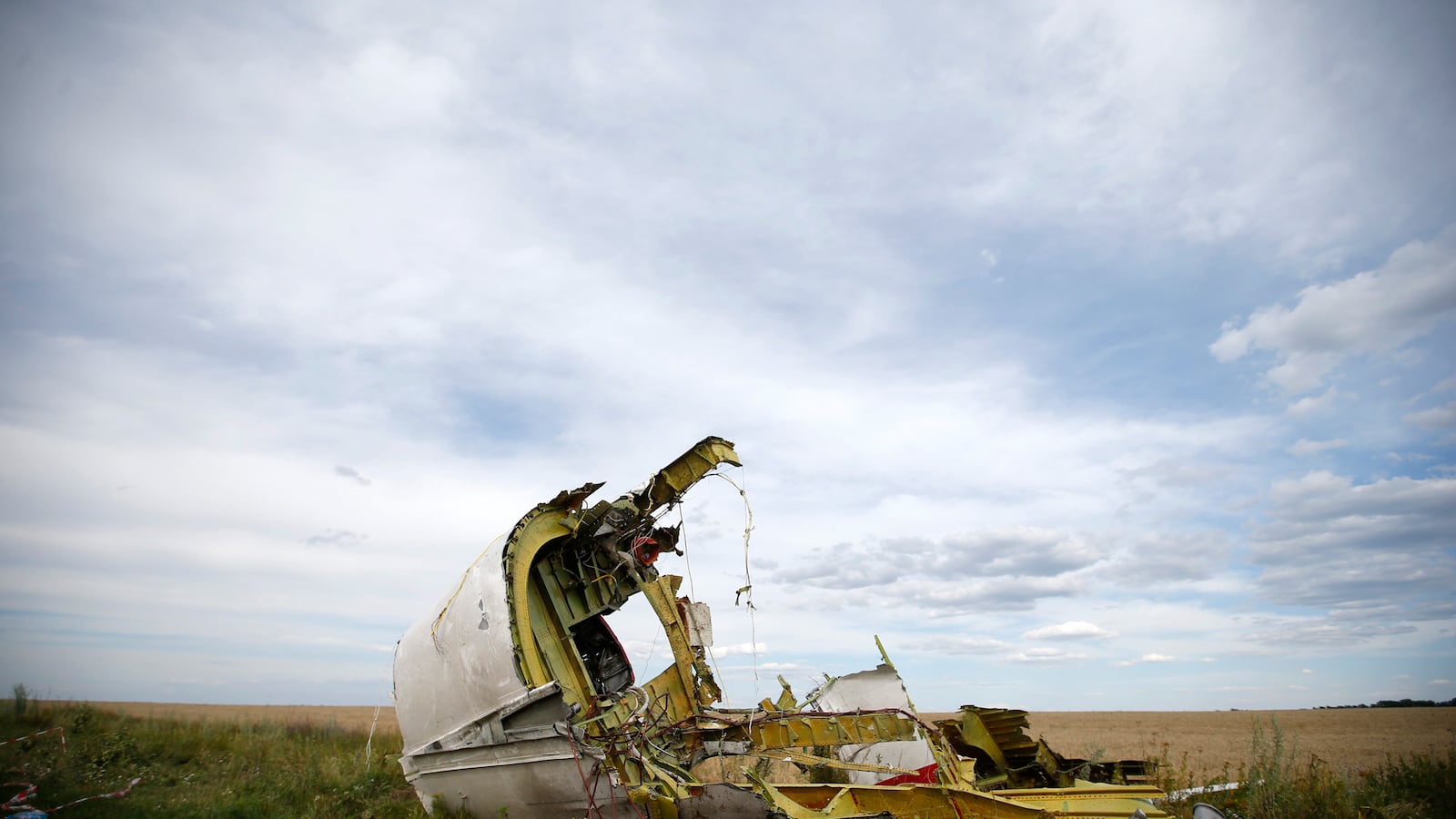As U.S. intelligence officials briefed reporters on the downing of Malaysia Flight 17 over Ukraine they were reflecting a striking fact: This air crash investigation is being conducted by an entirely new method—detailed scrutiny by journalists, social media and open-sourced intelligence from national agencies.
It almost seems that an “official” investigation will be redundant. To an extent never seen before, a combination of on-the-ground reporting, instant social media coverage, military intelligence and expert analysis is providing a remarkably complete forensic picture of what happened.
It is precisely because the wreckage of the Boeing 777 fell into a lawless land where the immediate normal quarantining of a crash site was not possible that an investigation “by any other possible means” has been put together, spontaneously and driven by a collective will to protect the truth.
Not only is this a graphic demonstration of the means available—a kind of organic cloud reporting, if you will—but it also shows that when a sense of international outrage is so manifest it generates the means to snatch the truth free of those who would wish to suppress it.
I doubt very much whether there was a desperate cover-up in the eastern Ukraine directed from Moscow. Far more likely is a hasty, panicky and improvised response from the gang of separatists and mercenaries who perpetrated the crime. The most important piece of evidence they wanted to remove immediately was not from the airplane. It was the missile battery.
There has been a lot of concern about contamination of the evidence at the site. In reality, it’s hard to deliberately mess up a debris field as large as this one. First of all, you would need to know which bits are likely to be the most damning, a knowledge unlikely to be present in this case. Secondly, large pieces of wreckage can’t be moved without someone seeing that happening. And, thirdly, even if you are moving pieces of wreckage, there are eyes in the sky watching it all from satellites.
Experts understood within minutes of the event that there were two distinct sources of crucial evidence: the flight data and cockpit voice recorders, more easily referred to as the black boxes although they are bright orange, and the wreckage itself.
The value of the black boxes is as prelude. They will record the exact moment of impact and the height and geographical position of the 777. They will also contain a very detailed picture of the mechanical condition of the flight—whether all its systems were in order. And something that in this case would be very useful to know: the voice recorders would tell us of any conversations between the pilots and air traffic controllers that might have discussed the dangers of being in that air space.
However, when it comes to the cause it is the wreckage that has the physical proof. The first thing investigators do after a site has been secured is to “read” the wreckage. From the distribution of the debris they can judge whether it hit the ground in one piece or fell in separate parts distributed over a wide area. They can tell if fire played a part, or whether the fire occurred after a mechanical failure. And they always want to get a detailed look at the engines to see if engine failure was involved.
In the case of Flight 17 the wreck is already yielding a lot of information. Satellite pictures show that at the heart of the debris field is a large area of intense fire where the earth has been scorched. Pictures taken of this at ground level show that the engines are severely damaged—fan blades are partly melted and distorted and the engine casings are broken open.
All of this is consistent with a violent explosion at altitude. The main fuel tanks would have been the principal source of this explosion—the 777 was still on its climb-out from Holland over Ukraine, not yet at its ultimate cruise height of 36,000 feet and heavy with fuel.
Beyond this fiery center of the debris other sections of the 777 were scattered, some in clusters, others in random pieces. The difference between the effects of the main fireball and other parts that broke away led to the most poignant and graphic pictures taken as people—local, military and others—roamed the fields. Personal effects as small as a boarding pass or passport showed no sign of fire. Carry-on bags from the overhead bins were intact.
The New York Times has reported what is probably the most conclusive piece of physical evidence—an aluminum panel photographed by Times reporters at the scene, part of the 777’s outer skin, is peppered with holes not from an interior explosion but from the exterior.
Impacts from the exterior can have only two causes. One is from shrapnel from an engine failure—this was very much in evidence when a Qantas Airbus A380 suffered an engine failure on its climb out from Singapore in 2010. The shrapnel took out some of the airplane’s critical control systems and very nearly caused it to crash.
The other source would be shrapnel from a missile.
Anti-aircraft missiles have a proximity fuse. As the missile closes on its target the warhead explodes before the missile strikes the airplane. In this way the missile does not need pinpoint accuracy: widely spread supersonic shrapnel from the warhead is deadly. It eviscerates the airplane’s whole structure. Early Russian surface-to-air missiles like the S-75 Dvina that brought down two U.S. U-2 spy planes deployed shrapnel in this way—one of the pilots died because his pressurized suit was punctured—and the SA-11 Buk missile, spawn of the S-75, uses the same method in a more devastating form.
The Times showed their photographs of the wreckage to an expert at HIS Jane’s, one of the world’s most respected authorities on weaponry. He confirmed that the punctures of the 777’s skin were consistent with the effects of high-velocity shrapnel that would result from a strike by an S-75.
As for evidence of who launched the missile and the location of the launch site in territory held by Ukraine separatists under Russian control, intelligence agencies in the U.S. and other nations have open-sourced their own information that pins the launch to 4:20 p.m. local time last Thursday, and the location between the towns of Snizhne and Torez in eastern Ukraine. The same sources recorded phone conversations said to include claims by separatists to have shot down the airplane. A video has appeared that experts believe shows the Buk missile battery being hastily withdrawn to the border with Russia.
U.S. officials admitted that their intelligence is not conclusive on who gave the order to fire the missile, or whether any Russians were directly involved.
Another vital source of evidence is pathological: the condition of the bodies of victims, which will show how they died. Many human remains will have been consumed in the central fireball, which makes DNA tests of bones vital; other bodies will show no sign of fire or of smoke inhalation, and their physical condition could indicate if they fell free of the main blast. Anatomical effects can be revealing of what happened to the airplane itself. For example, bodies recovered from Air France Flight 447 that crashed into the south Atlantic revealed severe spinal compression. From this it was possible to deduce that the airplane hit the ocean whole, and at what speed.
Many of the human remains are now on their way to Holland after being taken on refrigerated trains to airports free of separatist interference.
Meanwhile, in a bizarre ceremony conducted at night, the Ukrainian separatists handed over the black boxes to the Malaysians, putting them into a large plastic shopping bag. The recorders seemed to be largely intact, still safely sealed in their outer reinforced casings. They are being sent to the British Air Accident Investigation Branch for analysis, but the story they will tell is already foretold. This is the world’s first totally open-sourced air crash investigation, ad hoc, contributed to by numerous agents, digital and human, and now welling up into an international narrative that is driven by repugnance and extreme sadness.






